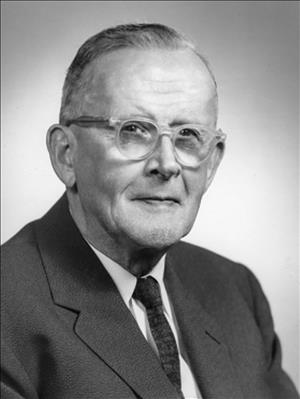On October 1, 1921, engineer Homer Hadley (1885-1967) formally proposes a floating concrete pontoon bridge across Lake Washington at a meeting of the American Society of Civil Engineers. Hadley conceived of the floating bridge as a way to overcome the challenge of the lake's extreme depth, which makes building deep foundation pilings impractical.
A Deep Lake To Bridge
Glacially carved Lake Washington, about 13 miles long, has a mean depth of 108 feet, and is 214 feet at its deepest point. The lake is about 150 to 200 feet deep at the bridge site, but another 100 feet of soft clay and mud lie below that. The span of the lake between Seattle and Mercer Island at the bridge site is about a mile and a half.
Franchise rights had been granted for a fixed (non-floating) bridge between Seward Park and Mercer Island in 1930 and 1935, but financing had fallen through. A wooden East Channel Bridge between Mercer Island and Enetai on the east shore of the lake was constructed in 1923.
Pontoon bridges originated as a military type of bridge engineering, and were usually not meant to be permanent structures, but due to Lake Washington’s relatively stable water level and its lack of strong currents (or seasonal ice-floes), a young engineering student named Homer Hadley thought a concrete pontoon bridge would work.
An Innovative Engineer
Homer Hadley, born in Ohio, came out west as part of a survey crew. He studied engineering intermittently at the University of Washington, doing the equivalent of about three years of study, but he never graduated with a degree. During World War I, he worked for a concrete ship and barge manufacturer in Philadelphia, so he had extensive knowledge of concrete and its flotation possibilities. He first proposed building a floating bridge across Lake Washington in 1920, while working as an engineer in the architectural office of the Seattle School District.
This formal proposal at the American Society of Civil Engineers meeting in 1921 stirred a lot of skepticism and debate amongst Seattle’s civic leaders and in the media. Hadley hoped to build it with private money and make it a toll bridge, but bankers nicknamed the idea “Hadley’s Folly,” and the project didn’t go anywhere.
Hadley got a job the same year as regional structural engineer with the Portland Cement Association, an organization promoting the use of concrete for large-scale projects. “From then on,” he said, “whenever I mentioned my idea, someone would express the fear that it was part of a nefarious plot of the cement companies to desecrate Lake Washington for profit” (HAER, p. 3)
In 1937, after federal money became available to the states during the Great Depression, Hadley went with his idea to then Director of Highways for the Washington Transportation Department, Lacey V. Murrow. The floating bridge concept intrigued Murrow, and after careful study, his staff told him it was feasible. After Murrow had its construction underway (construction began in December 1938), he told Hadley he should take a back seat in consideration of the possible flack the Department would receive for the conflict of interest because of Hadley’s association with the cement industry. Murrow assured Hadley he would get his proper recognition for the bridge after it was built, but he did not keep his promise.
From "Hadley's Folly" to Historic Bridge
The Lake Washington Floating Bridge (also called Mercer Island Bridge) opened on July 2, 1940, to great fanfare, and at 6,620 feet long (the pontoon section only), it was the world’s largest floating structure at the time. The bridge was responsible for the opening up of the Eastside and turning Mercer Island and Bellevue into Seattle suburbs as well as thriving communities on their own terms.
After Murrow’s death in 1967, the bridge was re-dedicated as the Lacey V. Murrow Memorial Bridge. University of Washington Alumni began a statewide campaign to rename the second bridge across the span (built in 1989), as the Homer M. Hadley Memorial Bridge. State Legislature unanimously approved the effort and it was re-dedicated as such in July 1993.
The Lacey V. Murrow Bridge sank on November 25, 1990, as it was being refurbished. The bridge was rebuilt and completed in 1993.

